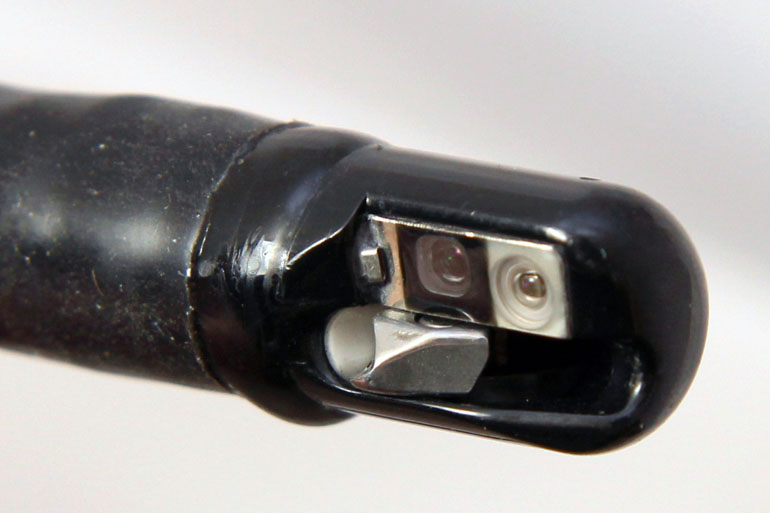The Food and Drug Administration has dropped a recall of some 2,800 scope-cleaning machines in use at hospitals and clinics nationwide despite a finding by a top agency scientist last year that the action was “necessary to protect public health.”
The FDA had ordered the equipment off the market in November because it said Custom Ultrasonics of Ivyland, Pennsylvania, had repeatedly violated federal safety laws and those lapses could increase the risk of infection for patients. The agency reiterated the recall in January after a Senate report linked Custom’s machines to several superbug outbreaks across the country.
Now the FDA has backed off, saying the company’s signature product, the System 83 Plus machine, can remain in the field while regulatory issues are being addressed.
Regulators and the company said these sophisticated washing machines known as Automated Endoscope Reprocessors (AERs) still cannot be used to disinfect a specific type of gastrointestinal scope called a duodenoscope that’s been tied to 41 infection outbreaks worldwide and at least 24 deaths in the U.S. But the machines can be used to wash other endoscopes, despite the company’s history of regulatory troubles since 2007.
“Based on information provided by the company, the FDA has determined that the products may remain in the field,” the agency said in a statement.
A spokeswoman for the FDA declined to discuss the new information that the company provided.
Custom Ultrasonics Chief Executive Alicia Nakonetschny didn’t respond to a request for comment. She touted the reprieve last week and expressed optimism about receiving FDA clearance for all scopes at some point.
“We want to assure our customers who reprocess duodenoscopes that we are working with FDA to resolve duodenoscope issues as quickly as possible,” she said on the company’s website.
Lawrence Muscarella, a former director of infection control at Custom Ultrasonics, where he worked for 18 years, questioned the FDA’s actions.
“It is certainly troubling for the FDA to order the removal of a medical device it has linked to patient injuries and deaths and then to abruptly reverse course with no clear explanation,” said Muscarella, who left the company in 2013 because of what he called safety concerns.
“This may be unprecedented in the history of medical device regulation,” he added.
Custom Ultrasonic scope-cleaning machines can cost $30,000 to $50,000 and typically take about 30 minutes to wash scopes with disinfectant following some manual cleaning. About 1,000 hospitals and clinics nationally rely on the company’s equipment to prepare reusable endoscopes for the next patient.
A Senate investigation on the superbug outbreaks released in January was sharply critical of Custom Ultrasonics. That found that the company’s machines were used by at least nine of 16 U.S. hospitals that had been identified at the time as having scope-related infections. The infections occurred during a procedure in which a scope is threaded down a person’s throat to diagnose and treat problems in the digestive tract, such as gallstones, cancers and blockages.
Some of the affected hospitals included Thomas Jefferson University Hospital in Philadelphia, Massachusetts General in Boston, and University of California, Los Angeles’ Ronald Reagan Medical Center.
“Considering that only about 10 to 20 percent of the AERs used in American hospitals are Custom Ultrasonics AERs, it appears the defective machines played a significant role in allowing the duodenoscopes to remain contaminated between uses,” the Senate investigation concluded.
The Senate report added, however, that scope-related infections cannot be solely attributed to the company’s equipment.
Health officials have focused much of their attention on the design of the gastrointestinal scopes that makes it difficult to remove dangerous bacteria. Deadly germs can become trapped inside the scope and then get passed to the next patient.
But in November, FDA officials said Custom Ultrasonics couldn’t prove that its equipment could adequately disinfect endoscopes in general. The firm also didn’t report adverse events tied to its equipment within 30 days, such as a 2013 incident involving a scope-related infection and a System 83 unit that malfunctioned, officials said.
The FDA recall order “is necessary to protect the public health,” the FDA’s chief scientist for medical devices, Dr. William Maisel, said in November.
Even before the latest reversal, some patient-safety advocates had criticized the FDA for taking too long to pull Custom Ultrasonics products off the market.
In 2007, the FDA announced that the company had signed a federal consent decree because its “actions posed a potential public health hazard because endoscopes that are not properly cleaned and disinfected can be a source of transmission of pathogens between patients.”
In 2012, the FDA told Custom Ultrasonics to cease manufacturing and ordered a recall of all System 83 devices because of concerns over patient safety. But federal officials said they allowed Custom’s equipment to remain on the market after the company made changes.
The 2012 FDA order stemmed, in part, from Custom Ultrasonics’ failure to obtain government clearance for its System 83 unit, which included a significant upgrade to the machine’s operating system.
FDA inspectors expressed concerns about computer-related problems interrupting the cleaning cycle on Custom equipment and possibly compromising patient safety.
Custom “failed to fully identify the health risk to the patient population if current products in distribution with potentially nonconforming computer hardware components should fail,” an FDA investigator wrote in 2012.
Federal prosecutors continue to investigate several device manufacturers in connection with the superbug outbreaks at U.S. hospitals. Members of Congress have also introduced legislation aimed at improving device safety in response to the infections.
This story was produced by Kaiser Health News, which publishes California Healthline, a service of the California Health Care Foundation.
